I found this application in AD's OP77 datasheet:

Apparently they (ab)use a 2N930 transistor's B-C's junction as a low-leakage diode. Is there any reason why you would choose a transistor over a real low-leakage diode for this?
I found this application in AD's OP77 datasheet:

Apparently they (ab)use a 2N930 transistor's B-C's junction as a low-leakage diode. Is there any reason why you would choose a transistor over a real low-leakage diode for this?
The reason is all about leakage current. The B-C junction outperforms all low leakage diodes by more than a factor of 10. A highly used low leakage diode, the BAV116, is rated to 5nA of rev leakage current. The B-C junction of a 2N3904 is well below 30pA at room temperature. Using the B-E junction is even lower leakage, usually around 5pA. You can't touch this with standard low leakage diodes. There are very pricey FET based diodes that are lower, but they are rare. The B-C junction advantage is that its reverse voltage is that of the transistor. Using B-E the junction will "Zener" at 6-7 volts. Still quite useful in low voltage circuits or even as an asymmetric clamp.
I have used 2N3904s for low leakage diodes for years with excellent results. Just pay attention to maximum forward current through your selected junction.
In the example circuit the B-C junction was used because of the range of voltage. It increased the holdup time of the sample capacitor by reducing rev leakage back to the op-amp output. I would think the leakage of the reset mosfet will dominate this circuit as the input bias of the AD820 is typically 2pA.
The reason is a recovery time. Diode can have 3 microseconds, BJT is just a 5pF * N ohm ~ dozen of nanoseconds. The diode is better than BJT in slower range, it has pA current, when BJT has nA.
Physics of fast recovery for BJT can be explained by very low volumetric capacitance (low charge) of base, because BJT base is very thin by design.
I guess low leakage diodes have much longer distance across junction (falling doping gradients or even gaps), when carriers must approach region by thermal diffusion, tonneling, which takes time. The diode gap has very large volume (comparing to BJT base volume) to fill with carriers during recovery time.
Thermal characteristics? BJT can be heat sinked quite easily with a clip-on, or case mounted for mechanical thermal coupling. If the op amp OP77 are also chosen as circular case, then a dual-mounted heatsink is simple to mechanically fit.